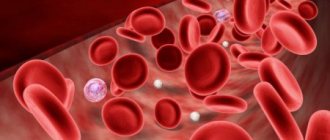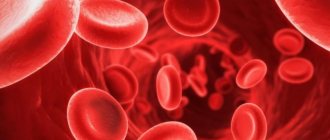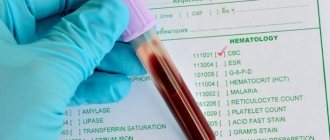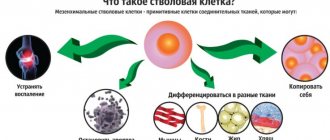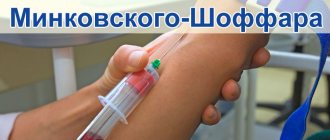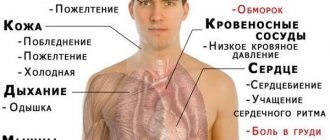How does the number of red blood cells and hemoglobin depend on childhood?
Childhood anemia most often occurs before the age of 3 years. This is due to the high sensitivity of a small organism to the aggressive effects of factors that provoke the development of anemia.
As soon as a child is born, the body begins to actively produce red blood cells - erythrocytes. Their number changes with age, both smaller and larger.
Until the age of 6 months, the child retains reserves of hemoglobin, which was given to him by his mother in the womb. After six months, active production of a substance that delivers oxygen to cells begins.
Another turning point occurs during the child's puberty. The body of a 12-year-old teenager begins to produce more red blood cells and, thereby, provokes an increase in hemoglobin. The dependence of the number of red blood cells and hemoglobin on childhood is presented in Tables 1 and 2. By assessing the data, you can see the critical periods described.
Table 1 - Change in the number of red blood cells
| Child's age | Red blood cell count (x1012/l) |
| 0 - 1 week | 4 — 6,6 |
| 2 weeks | 3,6 — 6,2 |
| 2 – 6 months | 2,7 — 4,9 |
| 12 months | 3,6 — 4,9 |
| 3 – 12 years | 3,6 — 4,7 |
| over 13 years | 3,6 — 5,6 |
Table 2 - Change in hemoglobin level
| Child's age | Hemoglobin level, g/l |
| 2 weeks | 134 — 198 |
| 1 month | 107 — 171 |
| 6 months | 110 — 141 |
| 12 months | 113 — 141 |
| 2-5 years | 110 — 140 |
| Up to 12 years | 120 — 150 |
| Over 12 years | 120 - 166 (boys), 115-153 (girls) |
In addition, the data presented are influenced by illnesses suffered in childhood, malnutrition or improper artificial feeding.
General information
Probably many people know what anemia is, since the disease occurs in almost every 6-7 inhabitants of the planet. Anemia is characterized by a sharp decrease in the concentration of hemoglobin and hematocrit in the blood (red blood rings). For men and women, all indicators are different.
For example, the norm of hemoglobin and hematocrit in the blood is:
- If in women the level is not lower than 120-125 g/liter. The hematocrit should be at least around 35-36%.
- If in men the indicators are not lower than 130-135 g/liter. The minimum hematocrit level is 39-40%.
Table of hemoglobin norms in adults and children
Today, in almost 15-25% of the population, various types of anemia are diagnosed annually. As a rule, most cases of anemia occur in women, especially during pregnancy or lactation. Less commonly, you can find anemia that is associated with a deficiency of folic acid or vitamin B12, in other words, megaloblastic, aplastic anemia and, of course, the hemolytic form.
The most common is first-degree anemia, which develops against the background of iron deficiency in the blood (about 85-90% of all cases). Normochromic anemia occurs in about 30-35 of all cases. It should be noted that normochromic anemia can have a complex form (combinations of 2 or 3 types at the same time).
Causes of the disease in infants
There are many reasons for the development of anemia. Their appearance depends on the type of anemia diagnosed. Anemia can develop either due to minor factors or indicate the presence of severe pathological processes in the body.
Conventionally, the reasons leading to a decrease in hemoglobin in the blood are divided into three groups:
- antenatal;
- intrapartum;
- postnatal.
Factors that arise during a woman’s pregnancy
The body of a woman carrying a fetus actively transports iron into the womb throughout pregnancy. This is how a kind of supply of substance is formed for the newborn.
If a pregnant woman has some pathologies, it is quite possible that due to a disruption in the iron transport system, the child will develop anemia. Such diseases include:
- gestosis;
- premature placental abruption;
- premature birth;
- anemia;
- pregnancy with twins or triplets;
- development of bleeding;
- chronic hepatitis.
Factors encountered during childbirth
Usually the development of anemia in a newborn is provoked by large blood loss of the mother. Bleeding during childbirth can be caused by:
- placental abruption before term;
- insufficient treatment of the umbilical cord residue;
- tying the umbilical cord too early or late;
- causing damage with obstetric instruments.
Other factors that appear during the development of the newborn
There are many types of postnatal factors. The causes of childhood anemia may vary. The main ones are:
- hematopoietic pathologies;
- significant or frequent blood loss (nosebleeds, surgery);
- disruption of iron absorption processes (rickets, cystic fibrosis, lactase deficiency);
- development of allergic reactions on the skin;
- other diseases (pyelonephritis, leukemia, tuberculosis).
Traditional medicine recipes
Traditional medicine recipes for grade 1 anemia have been known since ancient times. All methods were tested by ordinary people. Therefore, it is not strange that many patients turn to ancient recipes to this day.
There are several ways to help cure anemia in adults and children at home:
- Rowan tea. You need 2 tsp. pour 2 cups of boiling water over the berries. Let it steep (about 30-40 minutes). It is recommended to drink tea ½ cup 2-3 r. for a day. This recipe can be used to brew blueberries or rose hips.
- It is recommended to brew soup from young nettle leaves. You will need a few young leaves, throw them into boiling water and let them boil for about 5-10 minutes. It is recommended to eat this healthy soup 1p. for 2-3 days.
- Mix the juices of pomegranate, carrots, lemon, apple and beets in equal proportions. Add 1-2 tbsp. honey The juice must be stored in a cool and dark place. Use 2 tbsp. 3 rubles each for a day.
There are many more folk remedies that will help cope with anemia. But still, before using them, consult your doctor. After all, you don’t know how this or that recipe can affect your well-being.
It is pointless to argue about whether grade 1 anemia is dangerous. Like any other disease, anemia can cause irreversible processes in the body. There is no need to treat the disease yourself under any circumstances.
Existing types of anemia
Depending on what factors influence the appearance of anemia in a child, several types of this pathology are distinguished. Based on this, appropriate treatment is prescribed.
Iron deficiency anemia
In the vast majority of cases, anemia in a child develops precisely because of insufficient iron intake. This is due to the constant development of the child’s body, which requires the transportation of increased portions of iron into the cells. If there is insufficient consumption of iron-containing foods or medications, iron deficiency develops.
Caused by a decrease in porphyrin levels
Sideroachrestic anemia can be caused by a violation of the synthesis of one of the components of hemoglobin. This occurs due to insufficient amounts of protoporphyrin.
The development of this type of anemia is associated with several factors:
- Hereditary.
Due to the difficulties of inheritance, congenital sideroachrestic anemia affects predominantly males.
- Purchased.
The development of the disease occurs due to lead poisoning or prolonged consumption of alcoholic products or certain specific drugs. Due to the presence of excess metal, the level of porphyrins begins to decrease. The occurrence of anemia is influenced by the factor of being in harmful conditions, which involve working with metal-containing dust or particles.
Treatment involves complete removal of the dangerous metal from the body.
Iron and vitamin deficiency
Dimorphic anemia is quite rare. It has signs characteristic of both ordinary iron deficiency anemia and peridoxin deficiency anemia. This is due to the presence of certain factors and diseases that provoke the simultaneous development of iron deficiency and lack of vitamin B12.
Consequence of hematopoietic disorder
Hypoplastic, or aplastic, anemia has a number of characteristics that are distinctive from iron deficiency anemia:
- the process of bone hematopoiesis begins to be sharply inhibited;
- the quantitative level of adipose tissue is much higher than the content of hematopoietic cells;
- possible presence of hemorrhagic syndrome on the skin.
Typically, aplastic anemia provokes the development of various infections that cause serious complications in the course of the disease.
Anemia due to insufficient vitamin B12
Pyridoxine deficiency anemia occurs due to insufficient amounts of vitamin B12 in the child’s body. The reason for this may be pathologies of the hematopoietic process. With the help of a clinical study, not only a decrease in the level of the vitamin is observed in the blood, but also an increase in bilirubin. In order to timely diagnose concomitant diseases of internal organs, the child is prescribed additional examinations.
Hereditary
Thalassemia is considered an inherited disease caused by abnormalities in the structure or production process of hemoglobin. Often the first symptoms appear at an early age. Visually, the disease can be recognized by a square head, flattened bridge of the nose, narrow eyes and a large upper jaw.
When the disease occurs, red blood cells are destroyed, and iron begins to accumulate in the organs. Diagnosis of thalassemia is carried out in the prenatal period. If at least one of the parents has a similar disease, the pregnant woman undergoes a series of diagnostic procedures in order to identify a hereditary disease in the fetus.
Anemia due to destruction of red blood cells
Hemolytic anemia can develop due to the presence of diseases in the child that provoke the breakdown of red blood cells. Diagnosing this type of anemia is much more difficult than detecting iron deficiency anemia.
The disease has specific symptoms, thanks to which doctors are more likely to identify anemia and save the child.
As a rule, hemolytic anemia develops from an early age. With a congenital disease, there is damage to the bone skeleton. The skin has a yellowish tint.
Tactics of drug therapy
Treatment of first degree anemia has several options, depending on the type of anemia. However, in all cases, the main emphasis is on replenishing iron and vitamin B12 deficiency.
Most often, high dosages of iron supplements (up to 300 mg/day) are prescribed, which are taken orally. If the hemoglobin level gradually recovers, the dose is reduced to therapeutic levels.
Modern iron preparations are often a complex of this element with vitamins B12, B9 and C.
If the patient has a malabsorption of iron due to pathology of the gastrointestinal tract, injectable forms of the drug are prescribed.
Aplastic and posthemorrhagic forms of anemia require a special approach to treatment. In the first case, therapy is aimed at restoring normal bone marrow function, so drugs are used that stimulate the division of blood cell precursors.
Only specialists can treat this type of pathology.
In the second case, blood transfusion is used in case of large blood loss. Replenishment of the normal number of red blood cells, correction of iron levels.
Stages of anemia
When anemia manifests itself, it has several stages of development. Each period has its own distinctive characteristics and methods of treatment.
- The period of development of anemia.
Iron reserves in cells begin to decrease, while hemoglobin levels still remain relatively normal. Minerals obtained from food are no longer absorbed and do not affect hemoglobin levels. Iron deficiency develops due to the inactivity of intestinal enzymes.
- Latent course of the disease.
The stage is also called hidden. The reason for this is a decrease in the level of iron in the blood serum.
- The period of pronounced activity of anemia.
Hemoglobin begins to decrease, reaching critical levels. Along with this, the production of red blood cells decreases and lower levels of red blood cells are visible in the blood.
Dr. Komarovsky talks about how you can find out about your hemoglobin level and the methods you can use to increase it.
Signs and symptoms of the disease
It is quite difficult to understand that a child is developing anemia without special laboratory tests.
However, there are common symptoms that indicate a decrease in hemoglobin.
- Pale skin.
Along with this, pallor of the mucous membranes may be observed. Nails begin to break for no reason, teeth are attacked by caries. It is possible that a child's taste preferences may change.
- Emotional changes.
The child becomes easily excitable and irritable. This is due to increased fatigue of the body against the background of iron deficiency. Parents may notice that their child begins to fall behind in school or physical activity.
- Cardiovascular syndrome.
The child may have low blood pressure, a fast heart rate, or shortness of breath.
- Decreased protective functions of the body.
The symptom manifests itself in the child's frequent illness.
- Internal organs such as the liver and spleen increase in size.
- Development of enuresis.
What to pay attention to during pregnancy?
A pregnant woman and her relatives should closely monitor their health. Even in the absence of visible manifestations, the fetus will be the first to feel the lack of oxygen.
The listed symptoms can lead to serious complications such as:
- lowering blood pressure;
- early toxicosis;
- placental abruption;
- hypoxia and fetal development disorders;
- premature birth;
- birth weakness;
- increasing the risk of bleeding during labor.
Manifestation of anemia in children in the first year of life
Iron deficiency in young children can cause various complications, including mental and physical developmental retardation. If you identify symptoms of anemia or detect a reduced hemoglobin level, you should immediately seek help from a specialist.
In a child under one year old, anemia may manifest itself in the following:
- against the background of pale skin, dry mucous membranes are noticeable;
- constant occurrence of stomatitis or conjunctivitis;
- decreased or absent appetite;
- frequent regurgitation, sometimes in large quantities;
- restless sleep.
Based on the fact that the listed symptoms may have other diseases, diagnosing anemia in an infant is very difficult. The main method remains a blood test for hemoglobin.
A feature of the development of anemia in a child under one year old is his ability to restore iron reserves by six months. In the absence of such sources, hemoglobin begins to fall. The immune system becomes weak and the body becomes vulnerable to infections. Timely diagnosis of anemia will help restore the child’s health and not put him at risk.
How to prevent the development of the disease
Prevention of anemia in children should begin already during pregnancy. The expectant mother must definitely monitor her diet, follow a diet, often walk in the fresh air, and, if necessary, take iron-containing mineral and vitamin complexes. After the birth of a baby, the prevention of anemia is natural feeding, good care, timely testing (diagnosis), and observation by a pediatrician.
At the first suspicion of anemia, you should not delay treatment - the sooner it is started, the lower the risk of developing more severe degrees of disease and other consequences.
Anemia and premature babies
In children born prematurely, anemia is quite common. The severity of the disease directly depends on the gestational age of the child. Due to some peculiarities in a premature baby, hematopoiesis ends already after birth.
In addition, children who were born prematurely experience changes in the shape of red blood cells and a reduction in their life expectancy.
There are many reasons for the development of anemia in a premature baby. This can be either weakening and incomplete development of the body, or difficult childbirth or a hereditary factor.
Anemia in infants born prematurely begins to manifest itself at the end of the first month of life. By 4 months, the peak development of the disease is observed. With timely treatment, the child recovers by 6-7 months.
If severe anemia is diagnosed, a specialist may recommend a blood transfusion. This procedure will help increase the number of red blood cells in the blood in a minimum period of time.
Causes
Common causes of anemia in children of any age can be identified:
- eating disorders;
- metabolic problems;
- hereditary pathologies;
- congenital defects;
- blood loss and injury;
- exacerbations and protracted course of chronic diseases;
- negative environmental environment.
Anemia in children is common and is usually easily corrected if prompt attention is paid to it. But a number of conditions are also caused by serious pathologies. The success of treatment depends on how quickly the doctor was able to determine the root cause of anemia.
Diagnosis of anemia
Diagnosing anemia in a child is a process consisting of several stages. Each of them has its own characteristics, but the most important of them is laboratory research. The combination of test results and medical history allows you to accurately diagnose the child and prescribe adequate treatment.
Initial survey
The most important questions that concern a doctor when making a diagnosis are:
- How balanced is the child’s nutrition and what kind of food does he receive (artificial or breastfeeding);
- the presence of cases of bleeding (heavy menstruation in girls, bleeding gums or nosebleeds);
- whether there have been cases of spleen removal in the family or whether there were some specific diseases.
Patient examination
First of all, the doctor examines the child’s skin and mucous membranes. Next, the abdomen is palpated to identify a pathological increase in the size of the internal organs. Blood pressure and heart rate must be measured, and lymph nodes can be palpated.
Clinical researches
A general blood test can detect developing anemia. Before the age of one year, this study is carried out several times to prevent the development of anemia or take appropriate measures.
In the transcript you can see some important indicators and their meanings:
- red blood cell count;
- hemoglobin level and its amount in red blood cells;
- reticulocytes;
- quantitative content of other blood elements.
The norms for the amount of hemoglobin in children based on the results of a blood test and critical values can be seen in Table 3.
Table 3 - Norms of hemoglobin indicators depending on the age of the child
| Child's age | Hemoglobin content, g/l | Critical hemoglobin level to diagnose anemia, g/l |
| 1 month | 115 — 175 | Less than 100 |
| 6 months - 6 years | 105 — 140 | Less than 100 |
| 7 – 12 years | 110 — 160 | Less than 115 |
Other examinations
Subsequent examination of the child is associated with the identification of any abnormalities in health. Ultrasound determines the degree of enlargement of internal organs. Endoscopy can confirm the presence of bleeding in the gastrointestinal tract or identify pathological conditions. Carrying out an ECG will give an idea of the work of the heart. In addition, the doctor may prescribe a chest x-ray or CT scan.
Treatment with medications
To treat anemia in a child, the pediatrician prescribes supplements containing iron. Treatment is long-term, reaching 3 months in some cases. Medicines have different forms of release for children of different ages.
- Drops.
They are used mainly for young children, starting from the moment of their birth. The advantage of such iron-containing preparations is the ability to add drops to a bottle of juice. Liquid medications are convenient to give to a child who cannot yet swallow a pill. Typically, pediatricians prescribe Maltofer or Hemofer.
- Syrups.
Starting from 2 years of age, a child can be treated with iron-containing syrup. Precise dosing of the medicine using a measuring cup allows you to give even the smallest doses to children. Of the drugs on the market in the form of syrup, the most popular are FerrumLek and Ferronal.
- Pills.
Each capsule of an iron-containing preparation is covered with a protective shell. Such medications prevent tooth enamel from turning yellowish. Tablets are prescribed for older children: “FerrumLek”, “Aktiferrin”, “Hemofer”.
Along with medications containing iron, herbal medicine may be recommended to the child. This is due, first of all, to possible disruption of the digestive system.
Diet diet
In addition to taking iron supplements, special nutrition is recommended. If the baby is not yet a year old, then it is necessary to include pureed vegetables, fruits, juices and meat puree in his diet. Infants need to change their regular milk formula to one fortified with iron.
Older children are prescribed a diet and are given sea fish fillets, liver, red low-fat meat, and beans. Vegetables and fruits are healthier to eat fresh: salads, juices and smoothies.
Pomegranate juice is rich in iron content. Vitamin C helps iron to be absorbed, so it is advisable to include rosehip decoction in your diet.
Dietary recommendations
Since in most cases of anemia occurs due to iron deficiency in the body, many experts recommend that patients consume more healthy foods high in iron. In addition, the patient's diet for anemia should be enriched with many other vitamins, since it has been proven that iron itself is not absorbed.
Iron-rich foods
Patients with anemia are advised to include the following foods in their daily diet:
- Egg yolk.
- Liver, beef heart, tongue dishes.
- Turkey meat.
- Dairy products.
- Nuts.
- Honey.
- Apples and peaches.
- Broccoli.
- Whole grain porridge.
- Dried fruits.
It is advisable to cook all dishes in a double boiler or eat them fresh!
Children under 6 months should not be given complementary foods! The baby receives iron and other vitamins from mother's milk or special infant formula. From 7-8 months, the child can be introduced to the diet with meat and fruit purees. Additionally, provide fresh fruit juices.

